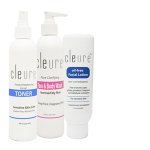Does Rosacea Laser Treatment
Work for Sensitive Skin?
If you are considering rosacea laser treatment, here are some facts that may help you to decide whether this is a good treatment option for your sensitive skin.
Did you know that one of out every five diagnoses made by dermatologists is for rosacea?
Rosacea is an unfortunately a very common chronic skin problem especially for people over 30. Some people begin to see signs of rosacea around age 25 with flushing and redness of the face.
If rosacea progresses, you will begin to see small red bumps on your face, some of which may look like acne sores. Eventually the face becomes permanently red and the skin thickens.
Although most rosacea sufferers are women, men who get rosacea are more likely to develop rosacea symptoms that cause the nose to become large and thickened.
If you begin to see signs that you may have rosacea, the time to take care of this is right now. Don't wait! Even though there is no known medical cure for rosacea, you may be able to reverse or even eliminate many of the symptoms.
To do this you will need early rosacea treatment combined with healthy lifestyle and diet adaptations that will help your skin to stop the cycle of inflammation and redness.
Initial Rosacea Treatments
Most dermatologists will initially treat rosacea with medications and topical creams, along with lifestyle and dietary instructions to minimize your rosacea outbreaks.
Sometimes these rosacea treatments, combined with a more healthy natural diet, are enough to get your rosacea under control. Many cases of sensitive skin respond well to a less toxic diet and lifestyle. If not, then your doctor will likely recommend rosacea laser treatment.
Rosacea Laser Treatment
Rosacea laser treatments first were used in the 1980's, and newer and gentler technologies were developed in the 1990's. These have shown some promise in treating some of the more severe rosacea symptoms like red bumps, spider veins, thickened skin, and permanently reddened skin.
These do have some risks and side effects for sensitive skin, and so you want to be cautious in your approach, and to work with a very skilled dermatologist to minimize any risks.
How Laser Treatment Works
A laser emits wavelengths of light which act on the swollen blood vessels right below the skin which cause the redness. The laser effectively disintegrates the swollen blood vessels, thus reducing the redness in the skin.
Lasers can also stop the thickening of skin that happens with advanced rosacea which can enlarge the nose and cheeks. In severe cases of rosacea, lasers can help the skin to return to a more normal and healthy appearance.
Rosacea Laser Treatment Side Effects
When you have sensitive skin, it is wise to be cautious before trying any kind of laser or surgical treatments. It is always best to try all the other options first such as a rosacea diet, rosacea home remedies, and rosacea medications FIRST.
The reason for this is because laser treatments are intense. They cause temporary bruising which last 1-2 weeks before fading. You may also experience a temporary darkening of the skin. You may see a lot of swelling and redness on your face for a few days.
In addition, laser treatments are not a rosacea cure. You may need lifelong follow up treatments.
After all this, there is a chance that rosacea laser treatments may not work. And for some people, they may actually make your rosacea worse.
Types of Rosacea Laser Treatment
There are new technologies coming out all the time that are attempting to create the maximum benefits for rosacea patients, with a minimum of bruising, redness and other side effects.
Although some research suggests that laser treatments that induce bruising MAY be more effective, this isn't an option that will work for many people who are unable to take several weeks away from their job until the bruising heals.
Most laser Treatments for rosacea fall into two categories:
- Pulsed Dye Laser (PDL) requires up to three treatments, spaced six to eight weeks apart.
- Intense Pulsed Light (IPL) is a newer technology which bruise less, and which require four to six treatments spaced three weeks apart.
Some new technologies such as a high-energy, long pulse-duration pulsed-dye laser are now emerging which are demonstrating better results, less side effects and less bruising.
Other Considerations for Rosacea Laser Treatment
Most laser treatments for rosacea cost anywhere from $300 to $600 per session. These treatments are generally not covered by medical insurance. As I mentioned before, laser treatments are NOT a rosacea cure, and you will likely need lifelong follow up treatments.
Another important thing to consider is your choice of doctor. You REALLY want to be sure that you choose a very skilled, very experienced doctor who has SPECIFIC knowledge of how to use laser treatment with rosacea. The reason for this is that the doctor needs to create an even skin tone for the entire face. If he or she over treats an area, you will have a white patch on your face!
Rosacea laser treatment may be an effective rosacea treatment for sensitive skin if you have exhausted all other treatment options and still have not found relief from your moderate or severe rosacea symptoms.
Educate yourself and be sure to choose an excellent doctor who has all the necessary skills, and who can help you make informed choices about your rosacea treatments. Done correctly, rosacea laser treatments have helped many people to ease their symptoms and to live more happily without the pain and embarrassment that rosacea can cause.
Home > Skin Care Articles > Rosacea Laser Treatment Article









New! Comments
Share your thoughts about what you just read! Leave me a comment in the box below.